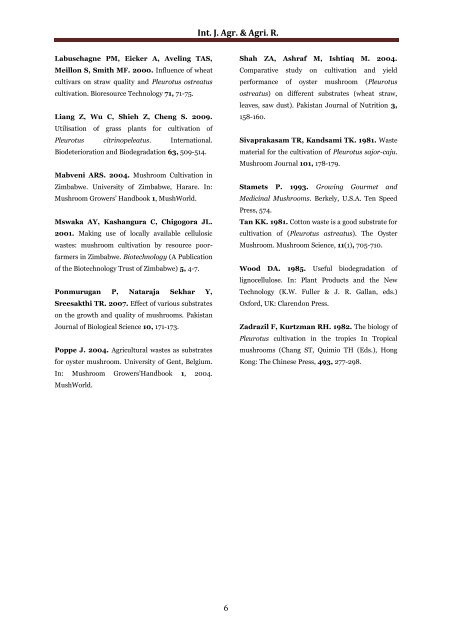Evaluation of cotton waste, paper waste and jatropha cake for culture of Pleurotus sajor-caju under different pasteurization methods
Abstract Identification of suitable substrate material and correct substrate pasteurization method is critical for successful oyster mushroom (Pleurotus sajor-caju) culture. An experiment was undertaken in a mushroom growing house to evaluate the effect of two pasteurization methods (boiling and use of Na hypochlorite) for P. sajor-caju culture on different substrates (cotton waste, waste paper and jatropha cake). A 3×2 factorial laid out in a completely randomized design (CRD) with three replications was used. Spawning was done at a rate of 8% and only the first three flushes were considered for the evaluation of substrate productivity. Mean number of basidiocarps (MNB), mean basidiocarp weight (MBW), biological efficiency (BE) and number of days to first fruiting (DFF) were used to evaluate substrate productivity. No fruiting was observed on jatropha cake under either pasteurization technique. Fruiting occurred on cotton waste and waste paper under both pasteurization methods. The results showed significant interaction effect (p<0.05) of substrate type and pasteurization method on MBW, BE and DFF. Cotton waste pasteurized by boiling method had highest productivity in terms of MNB, MBW and BE while waste paper pasteurized by Na hypochlorite solution had least productivity. However, waste paper pasteurized by boiling method took fewer DFF while cotton waste pasteurized by Na hypochlorite took the longest DFF hence delayed fruiting. Cotton waste proved to be the best substrate for P. sajor-caju production while boiling was the most effective pasteurization method. Jatropha cake is not suitable for oyster mushroom culture.
Abstract
Identification of suitable substrate material and correct substrate pasteurization method is critical for successful oyster mushroom (Pleurotus sajor-caju) culture. An experiment was undertaken in a mushroom growing house to evaluate the effect of two pasteurization methods (boiling and use of Na hypochlorite) for P. sajor-caju culture on different substrates (cotton waste, waste paper and jatropha cake). A 3×2 factorial laid out in a completely randomized design (CRD) with three replications was used. Spawning was done at a rate of 8% and only the first three flushes were considered for the evaluation of substrate productivity. Mean number of basidiocarps (MNB), mean basidiocarp weight (MBW), biological efficiency (BE) and number of days to first fruiting (DFF) were used to evaluate substrate productivity. No fruiting was observed on jatropha cake under either pasteurization technique. Fruiting occurred on cotton waste and waste paper under both pasteurization methods. The results showed significant interaction effect (p<0.05) of substrate type and pasteurization method on MBW, BE and DFF. Cotton waste pasteurized by boiling method had highest productivity in terms of MNB, MBW and BE while waste paper pasteurized by Na hypochlorite solution had least productivity. However, waste paper pasteurized by boiling method took fewer DFF while cotton waste pasteurized by Na hypochlorite took the longest DFF hence delayed fruiting. Cotton waste proved to be the best substrate for P. sajor-caju production while boiling was the most effective pasteurization method. Jatropha cake is not suitable for oyster mushroom culture.
Create successful ePaper yourself
Turn your PDF publications into a flip-book with our unique Google optimized e-Paper software.
Int. J. Agr. & Agri. R.<br />
Labuschagne PM, Eicker A, Aveling TAS,<br />
Meillon S, Smith MF. 2000. Influence <strong>of</strong> wheat<br />
cultivars on straw quality <strong>and</strong> <strong>Pleurotus</strong> ostreatus<br />
cultivation. Bioresource Technology 71, 71-75.<br />
Liang Z, Wu C, Shieh Z, Cheng S. 2009.<br />
Utilisation <strong>of</strong> grass plants <strong>for</strong> cultivation <strong>of</strong><br />
<strong>Pleurotus</strong> citrinopeleatus. International.<br />
Biodeterioration <strong>and</strong> Biodegradation 63, 509-514.<br />
Mabveni ARS. 2004. Mushroom Cultivation in<br />
Zimbabwe. University <strong>of</strong> Zimbabwe, Harare. In:<br />
Mushroom Growers’ H<strong>and</strong>book 1, MushWorld.<br />
Mswaka AY, Kashangura C, Chigogora JL.<br />
2001. Making use <strong>of</strong> locally available cellulosic<br />
<strong>waste</strong>s: mushroom cultivation by resource poorfarmers<br />
in Zimbabwe. Biotechnology (A Publication<br />
<strong>of</strong> the Biotechnology Trust <strong>of</strong> Zimbabwe) 5, 4-7.<br />
Ponmurugan P, Nataraja Sekhar Y,<br />
Sreesakthi TR. 2007. Effect <strong>of</strong> various substrates<br />
on the growth <strong>and</strong> quality <strong>of</strong> mushrooms. Pakistan<br />
Journal <strong>of</strong> Biological Science 10, 171-173.<br />
Poppe J. 2004. Agricultural <strong>waste</strong>s as substrates<br />
<strong>for</strong> oyster mushroom. University <strong>of</strong> Gent, Belgium.<br />
In: Mushroom Growers’H<strong>and</strong>book 1, 2004.<br />
MushWorld.<br />
Shah ZA, Ashraf M, Ishtiaq M. 2004.<br />
Comparative study on cultivation <strong>and</strong> yield<br />
per<strong>for</strong>mance <strong>of</strong> oyster mushroom (<strong>Pleurotus</strong><br />
ostreatus) on <strong>different</strong> substrates (wheat straw,<br />
leaves, saw dust). Pakistan Journal <strong>of</strong> Nutrition 3,<br />
158-160.<br />
Sivaprakasam TR, K<strong>and</strong>sami TK. 1981. Waste<br />
material <strong>for</strong> the cultivation <strong>of</strong> <strong>Pleurotus</strong> <strong>sajor</strong>-<strong>caju</strong>.<br />
Mushroom Journal 101, 178-179.<br />
Stamets P. 1993. Growing Gourmet <strong>and</strong><br />
Medicinal Mushrooms. Berkely, U.S.A. Ten Speed<br />
Press, 574.<br />
Tan KK. 1981. Cotton <strong>waste</strong> is a good substrate <strong>for</strong><br />
cultivation <strong>of</strong> (<strong>Pleurotus</strong> astreatus). The Oyster<br />
Mushroom. Mushroom Science, 11(1), 705-710.<br />
Wood DA. 1985. Useful biodegradation <strong>of</strong><br />
lignocellulose. In: Plant Products <strong>and</strong> the New<br />
Technology (K.W. Fuller & J. R. Gallan, eds.)<br />
Ox<strong>for</strong>d, UK: Clarendon Press.<br />
Zadrazil F, Kurtzman RH. 1982. The biology <strong>of</strong><br />
<strong>Pleurotus</strong> cultivation in the tropics In Tropical<br />
mushrooms (Chang ST, Quimio TH (Eds.), Hong<br />
Kong: The Chinese Press, 493, 277-298.<br />
6





![Review on: impact of seed rates and method of sowing on yield and yield related traits of Teff [Eragrostis teff (Zucc.) Trotter] | IJAAR @yumpu](https://documents.yumpu.com/000/066/025/853/c0a2f1eefa2ed71422e741fbc2b37a5fd6200cb1/6b7767675149533469736965546e4c6a4e57325054773d3d/4f6e6531383245617a537a49397878747846574858513d3d.jpg?AWSAccessKeyId=AKIAICNEWSPSEKTJ5M3Q&Expires=1714078800&Signature=0l0e7vMickgwFpYa215ycknntac%3D)












